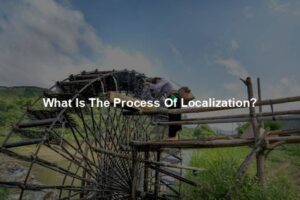
What Is Localization?
The Oxford English Dictionary defines localization as is making something local or restricting it to a particular place, which might be a country or a particular culture or belonging to a particular religious denomination.
In this article, we will look at language localization and the strategic stages or steps taken to achieve perfect localized content.
- With the world becoming a global village through the help of the internet, businesses, and companies out there expand and grow exceptionally. Regardless of whether you are a multinational company or just a small start-up, you have a global effect and push your business to a much bigger and higher level. With the help of a perfect set up website that includes all the nitty-gritty of your business in a well-organized manner, there is no reason your business wouldn’t have a wider reach globally. A website is the center of attention in your online presence and can be the instrument of manifesting your marketing strategies and make a worthwhile impact on them.
- If you are a business owner who has been living under a rock and does not understand what a website is, my advice to you is to get on that train and get yourself a website and wait to see how much it will boost your business locally and globally. To achieve this, your site should be visually attractive, contain great content, be user-friendly, functional, have a neat navigational design with qualitative graphics and images and apply the SEO principles.
- The first step is creating a general website and then localizing your website to fit the cultural aspects of any global country that you are targeting depending on what your business is about. What this does is that it speaks directly to the people in the country you are trying to reach and makes it easy for them to relate, which brings more sales to your business.
- Creating brand recognition and tapping into the global market used to be a real struggle for businesses, especially when you needed to reach different demographics with a respective knowledge of languages and cultural expectations. Today, this factor still determines the perception and judgment of customers–you want to receive it well. However, the digital world is always evolving and introducing new trends and ways that make a lot of work easier.
In this article, we will look at what localization is and the process in which we localize websites while outlining and explaining the different steps important in achieving a perfectly localized website. Localization is very paramount when dealing with an audience from a different country from yours, with a different cultural setup. Therefore, professionals should be the ones to localize content because they know exactly what they are doing because one thing you would not want is to offend your audience by either using expressions crude in their culture. Efficient communication with an international audience is key to keeping a global business competitive.
What is Website Localization?
Website Localization is the process in which we transfer a website’s content from one language to another local language belonging to a certain set of people.
- It’s a method used to translate language, requirements, and culture of a locale. You can localize any form of content you can think of, be it images, texts, expressions, advertisements, documents, interface and so and so forth. Its impact makes it easier for people to relate to your content because it is something they can relate with because it is not foreign. The World has become a global village and with the number of people using the internet growing each day, it’s very easy and possible for one to come across foreign content without trying too much. To communicate well with every member of the globe, to ensure that you pass across your message, it requires localization. Let’s look at the different steps important in achieving a well-localized website.
Steps on Website Localization.
- Research
- Just like any process, In-depth research is very paramount to achieving a perfect outcome that is not flawed. Depending on what exactly your target country is, you must be able to outline vividly what people your audience is, what is their culture like, does their language have words that are not polite, are there things considered as a crude or rude, etc? You also need to research on the impact the audience will bring to your business because more times than not it’s not about the audience but the impact they will have in your company and that is why you have to research about their purchasing power, products, services, and factors related to that. It’s important to have as much information that would come in handy to your target market when they are looking to engage with your services. Try researching aspects of the market condition, in-demand products, purchasing power, barriers to entry, laws, and regulations. To have a smoothly running business, it’s best to understand the needs of your target market by heart and localize your website to fit exactly that.
- Outlining a project
- After deciding on your target market and outlining some important factors that will help in putting your services out there, make sure you outline the whole project and know which countries you want to deal with and what languages they speak in those countries. What this does, is that it gives you an open view of your projections and it avoids confusion when the process officially begins. After deciding on what languages you want, it’s best to find a good localization service provider who will help you in realizing your vision. A good service provider will know how to programme languages and the exact number of pages that need localization, marketing strategies, SEO, and website design. This will make work easier for you because the service provider, who in this case must be a professional, will do most of the translation and language programming.
- Globalizing Time
- When the process of Localization starts, it’s always good for the service provider and website developers to know ways in which they can customize the websites to fit the specifics of different countries considering the fact that they have different time zones. One thing that happens is that time globalization is it which helps in internationalization. Developers know about internationalization and need to put the higher effort in a coding website that best suits every country. The programmer needs to have knowledge of coding source to the translation string so that each time you add a new language that code does not break the translation string. This step is the hardest, but the ultimate results are fruitful.
- Website Design According To Language
- The thing with websites is that there are a lot of factors to consider in making a perfect website. Therefore, even when localizing a website, all these factors need consideration. Things like the layout and the design of the website must be in line with the language that it’s being localized to. Some languages, written in a vertical form like Chinese and Korean, means your website design must incorporate these languages to give it a good look. What such languages do is that they force one to change the design of a website and if the plan is to have such languages, then a menu drop-down is the best way to go, that way someone can choose which language they want from the menu with no difficulties.
- Perfect Translation
- As I mentioned before, localization majorly deals with the translation of languages into local languages spoken in another country or even location. Doing these translations perfectly means we should use a professional service provider to avoid any mistakes.
- Use of SEO (Search Engine Optimization)
- If you are a writer, you know very well how important search engine optimization is. This is such an important tool that ranks websites in the internet world. Being able to know keywords used in the language you want to localize your content to, will make it easier for your target market to get online and search whatever they want, and direct them to your website.
- Selection of Right Images
- This is where the research you did on the first step comes in. The research will help you determine which images are acceptable in a certain country and which ones are not. It is good to use images that go hand in hand with the cultural values of your target market, to not offend them.
- Fast Website Speed is Vital
- Have you ever been on a website and the speeds are so low you end up clicking on another website? Yes, that is the most annoying thing that a lot of developers don’t look into. Therefore, when localizing your website it is important to make sure that the website speed is perfect and doesn’t take long to load. To make your website load fast, use images that are not big or make a mess with the websites’ content.
- Try Testing as Much as You Want
- Before putting the website out there for the world to see, be sure to give it a test run and ensure that all you took the steps into consideration. With this, you will know whether the website is ready to run.
In conclusion, it’s good to note that being able to adapt your content to fit different cultural values is the best way to go if the plan you have for your business is to be global. It might be a long and expensive process, but it is one process that will prove to be the best decision for your business.







